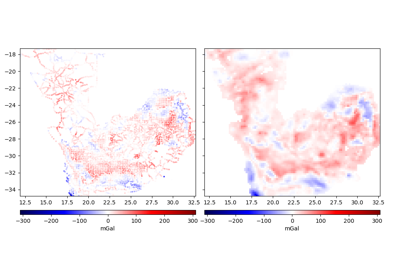harmonica.EquivalentSourcesSph¶
-
class
harmonica.EquivalentSourcesSph(damping=None, points=None, relative_depth=500, parallel=True)[source]¶ Equivalent sources for generic harmonic functions in spherical coordinates
These equivalent sources can be used for:
Spherical coordinates (geographic coordinates must be converted before use)
Regional or global data where Earth’s curvature must be taken into account
Gravity and magnetic data (including derivatives)
Single data types
Interpolation
Upward continuation
Finite-difference based derivative calculations
They cannot be used for:
Joint inversion of multiple data types (e.g., gravity + gravity gradients)
Reduction to the pole of magnetic total field anomaly data
Analytical derivative calculations
Point sources are located beneath the observed potential-field measurement points by default [Cooper2000]. Custom source locations can be used by specifying the points argument. Coefficients associated with each point source are estimated through linear least-squares with damping (Tikhonov 0th order) regularization.
The Green’s function for point mass effects used is the inverse Euclidean distance between the grid coordinates and the point source:
\[\phi(\bar{x}, \bar{x}') = \frac{1}{||\bar{x} - \bar{x}'||}\]where \(\bar{x}\) and \(\bar{x}'\) are the coordinate vectors of the observation point and the source, respectively.
- Parameters
damping (None or float) – The positive damping regularization parameter. Controls how much smoothness is imposed on the estimated coefficients. If None, no regularization is used.
points (None or list of arrays (optional)) – List containing the coordinates of the equivalent point sources. Coordinates are assumed to be in the following order: (
longitude,latitude,radius). Bothlongitudeandlatitudemust be in degrees andradiusin meters. If None, will place one point source below each observation point at a fixed relative depth below the observation point [Cooper2000]. Defaults to None.relative_depth (float) – Relative depth at which the point sources are placed beneath the observation points. Each source point will be set beneath each data point at a depth calculated as the radius of the data point minus this constant relative_depth. Use positive numbers (negative numbers would mean point sources are above the data points). Ignored if points is specified.
parallel (bool) – If True any predictions and Jacobian building is carried out in parallel through Numba’s
jit.prange, reducing the computation time. If False, these tasks will be run on a single CPU. Default to True.
- Variables
points_ (2d-array) – Coordinates of the equivalent point sources.
coefs_ (array) – Estimated coefficients of every point source.
region_ (tuple) – The boundaries (
[W, E, S, N]) of the data used to fit the interpolator. Used as the default region for thegridmethod.
Methods Summary
|
Filter the data through the gridder and produce residuals. |
|
Fit the coefficients of the equivalent sources. |
|
Get parameters for this estimator. |
|
Interpolate the data onto a regular grid. |
|
Make the Jacobian matrix for the equivalent sources. |
|
Evaluate the estimated equivalent sources on the given set of points. |
|
|
|
|
|
Score the gridder predictions against the given data. |
|
Set the parameters of this estimator. |
-
EquivalentSourcesSph.filter(coordinates, data, weights=None)¶ Filter the data through the gridder and produce residuals.
Calls
fiton the data, evaluates the residuals (data - predicted data), and returns the coordinates, residuals, and weights.No very useful by itself but this interface makes gridders compatible with other processing operations and is used by
verde.Chainto join them together (for example, so you can fit a spline on the residuals of a trend).- Parameters
coordinates (tuple of arrays) – Arrays with the coordinates of each data point. Should be in the following order: (easting, northing, vertical, …). For the specific definition of coordinate systems and what these names mean, see the class docstring.
data (array or tuple of arrays) – The data values of each data point. If the data has more than one component, data must be a tuple of arrays (one for each component).
weights (None or array or tuple of arrays) – If not None, then the weights assigned to each data point. If more than one data component is provided, you must provide a weights array for each data component (if not None).
- Returns
coordinates, residuals, weights – The coordinates and weights are same as the input. Residuals are the input data minus the predicted data.
-
EquivalentSourcesSph.fit(coordinates, data, weights=None)[source]¶ Fit the coefficients of the equivalent sources.
The data region is captured and used as default for the
gridmethod.All input arrays must have the same shape.
- Parameters
coordinates (tuple of arrays) – Arrays with the coordinates of each data point. Should be in the following order: (
longitude,latitude,radius, …). Onlylongitude,latitude, andradiuswill be used, all subsequent coordinates will be ignored.data (array) – The data values of each data point.
weights (None or array) – If not None, then the weights assigned to each data point. Typically, this should be 1 over the data uncertainty squared.
- Returns
self – Returns this estimator instance for chaining operations.
-
EquivalentSourcesSph.get_params(deep=True)¶ Get parameters for this estimator.
- Parameters
deep (bool, default=True) – If True, will return the parameters for this estimator and contained subobjects that are estimators.
- Returns
params (dict) – Parameter names mapped to their values.
-
EquivalentSourcesSph.grid(upward, region=None, shape=None, spacing=None, dims=None, data_names=None, **kwargs)[source]¶ Interpolate the data onto a regular grid.
The grid can be specified by either the number of points in each dimension (the shape) or by the grid node spacing. See
verde.grid_coordinatesfor details. All grid points will be located at the same upward coordinate. Other arguments forverde.grid_coordinatescan be passed as extra keyword arguments (kwargs) to this method.If the interpolator collected the input data region, then it will be used if
region=None. Otherwise, you must specify the grid region. Use the dims and data_names arguments to set custom names for the dimensions and the data field(s) in the outputxarray.Dataset. Default names will be provided if none are given.- Parameters
upward (float) – Upward coordinate of the grid points.
region (list = [W, E, S, N]) – The west, east, south, and north boundaries of a given region.
shape (tuple = (n_north, n_east) or None) – The number of points in the South-North and West-East directions, respectively.
spacing (tuple = (s_north, s_east) or None) – The grid spacing in the South-North and West-East directions, respectively.
dims (list or None) – The names of the northing and easting data dimensions, respectively, in the output grid. Default is determined from the
dimsattribute of the class. Must be defined in the following order: northing dimension, easting dimension. NOTE: This is an exception to the “easting” then “northing” pattern but is required for compatibility with xarray.data_names (list of None) – The name(s) of the data variables in the output grid. Defaults to
['scalars'].
- Returns
grid (xarray.Dataset) – The interpolated grid. Metadata about the interpolator is written to the
attrsattribute.
-
EquivalentSourcesSph.jacobian(coordinates, points, dtype='float64')[source]¶ Make the Jacobian matrix for the equivalent sources.
Each column of the Jacobian is the Green’s function for a single point source evaluated on all observation points.
- Parameters
coordinates (tuple of arrays) – Arrays with the coordinates of each data point. Should be in the following order: (
longitude,latitude,radius, …). Onlylongitude,latitudeandradiuswill be used, all subsequent coordinates will be ignored.points (tuple of arrays) – Tuple of arrays containing the coordinates of the equivalent point sources in the following order: (
longitude,latitude,radius).dtype (str or numpy dtype) – The type of the Jacobian array.
- Returns
jacobian (2D array) – The (n_data, n_points) Jacobian matrix.
-
EquivalentSourcesSph.predict(coordinates)[source]¶ Evaluate the estimated equivalent sources on the given set of points.
Requires a fitted estimator (see
fit).- Parameters
coordinates (tuple of arrays) – Arrays with the coordinates of each data point. Should be in the following order: (
longitude,latitude,radius, …). Onlylongitude,latitudeandradiuswill be used, all subsequent coordinates will be ignored.- Returns
data (array) – The data values evaluated on the given points.
-
EquivalentSourcesSph.profile(point1, point2, size, dims=None, data_names=None, projection=None, **kwargs)[source]¶ Warning
Not implemented method. The profile on spherical coordinates should be done using great-circle distances through the Haversine formula.
-
EquivalentSourcesSph.scatter(region=None, size=None, random_state=None, dims=None, data_names=None, projection=None, **kwargs)[source]¶ Warning
Not implemented method. The scatter method will be deprecated on Verde v2.0.0.
-
EquivalentSourcesSph.score(coordinates, data, weights=None)¶ Score the gridder predictions against the given data.
Calculates the R^2 coefficient of determination of between the predicted values and the given data values. A maximum score of 1 means a perfect fit. The score can be negative.
If the data has more than 1 component, the scores of each component will be averaged.
- Parameters
coordinates (tuple of arrays) – Arrays with the coordinates of each data point. Should be in the following order: (easting, northing, vertical, …). For the specific definition of coordinate systems and what these names mean, see the class docstring.
data (array or tuple of arrays) – The data values of each data point. If the data has more than one component, data must be a tuple of arrays (one for each component).
weights (None or array or tuple of arrays) – If not None, then the weights assigned to each data point. If more than one data component is provided, you must provide a weights array for each data component (if not None).
- Returns
score (float) – The R^2 score
-
EquivalentSourcesSph.set_params(**params)¶ Set the parameters of this estimator.
The method works on simple estimators as well as on nested objects (such as
Pipeline). The latter have parameters of the form<component>__<parameter>so that it’s possible to update each component of a nested object.- Parameters
**params (dict) – Estimator parameters.
- Returns
self (estimator instance) – Estimator instance.

